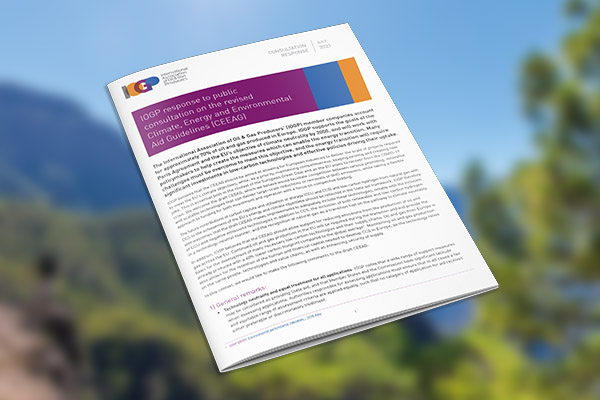28.07.2021
IOGP response to public consultation on the revised Climate, Energy and Environmental Aid Guidelines (CEEAG)
This document provides IOGP’s input to the EU public consultation on the revised Climate, Energy and Environmental Aid Guidelines (CEEAG).
Context
The Commission published for consultation the draft revised Guidelines on State aid for environmental protection and energy 2014-2020. The two main drivers of the revision are an enlargement of the scope of the Guidelines to new areas and all technologies that can deliver the Green Deal and a flexibilization of compatibility rules.
Key Points
- IOGP believes that the CEEAG should be aimed at allowing for European industries to deliver the scale of projects required to meet the EU’s climate objectives, while, as a priority, maintaining competitiveness, keeping existing and creating new jobs
- The future contributions of carbon capture and utilisation or storage (CCU and CCS) and low-carbon hydrogen from natural gas with CCS to the achievement of the EU’s energy and climate objectives should be reflected in the State aid framework
- The CEEAG should allow support for reducing emissions from the production of oil and gas across the EU. Continued oil and gas production in the EU will be required during the transition and will provide the basis for the development of many necessary low-carbon technologies and their supply chains
Overview
- General remarks
- Ensuring that the definitions of CCS and CCU cover all relevant sources of CO2
- Including all CO2 transport modes in the definitions for energy infrastructure
- Including all relevant low-carbon gas technologies and solutions in the definitions of energy infrastructure
- Eligibility for PCI and PMI status according to the definitions of energy infrastructure
- Adequately covering natural gas-based technologies, ensuring legal certainty and reflecting regional conditions in the definitions of “cogeneration”, “high-efficiency cogeneration” and “energy-efficient district heating and cooling”
- Facilitating the coal-to-gas shift in the context of GHG emission reduction
- Facilitating necessary investments in gas infrastructure
- Anticipating the electrification of new sectors in the context of reductions from electricity levies
- Publications
- News
- Events

08.07.2024
Position Statement
IOGP Europe key principles on a future regulatory framework for CO2 transport infrastructure
General comments:
For CCS to reach commercial scale, it is crucial to develop a reliable infrastructure, both onshore and offshore, to ensure the transport of captured emissions from the source to...
Read more
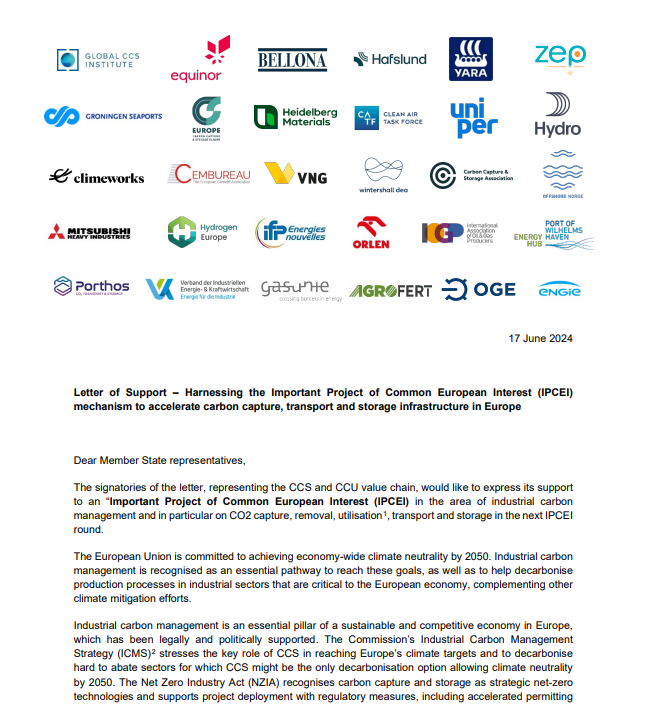
17.06.2024
Letter to Officials
Joint Statement – Harnessing the IPCEI mechanism for CCS in Europe
Dear Member State representatives,
The signatories of the letter, representing the CCS and CCU value chain, would like to express its support to an “Important Project of Common European Interest...
Read more
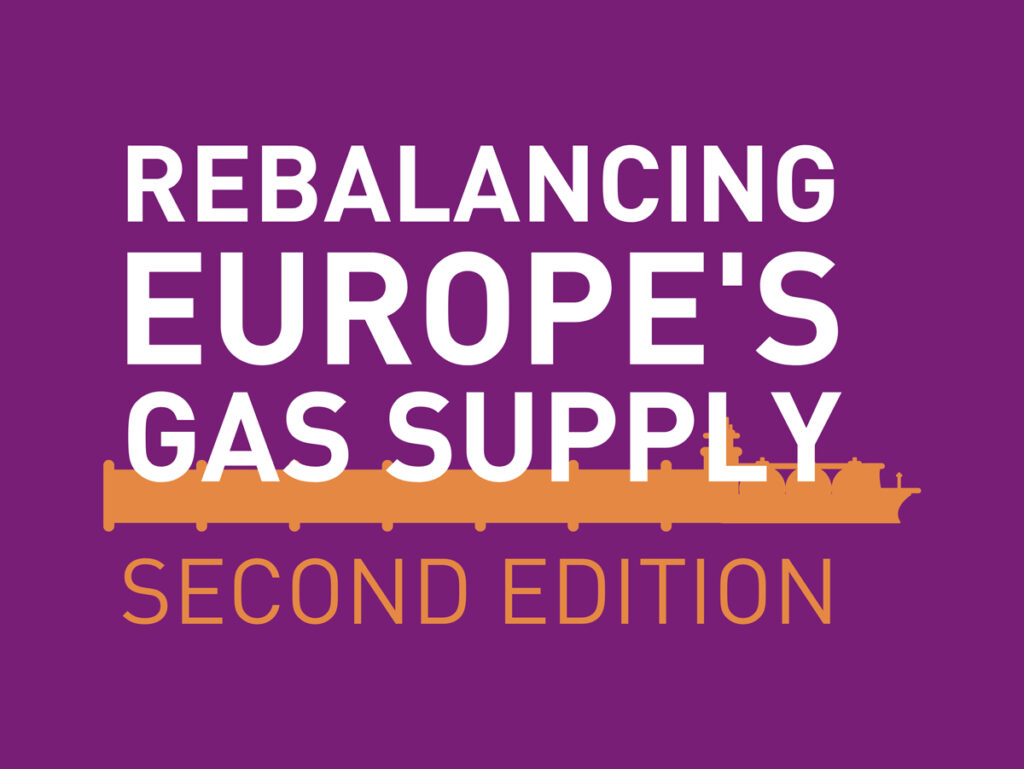
14.12.2023
Rebalancing Europe’s Gas Supply Second Edition
Rebalancing Europe's Gas Supply Second Edition - IOGP Europe...
Read more
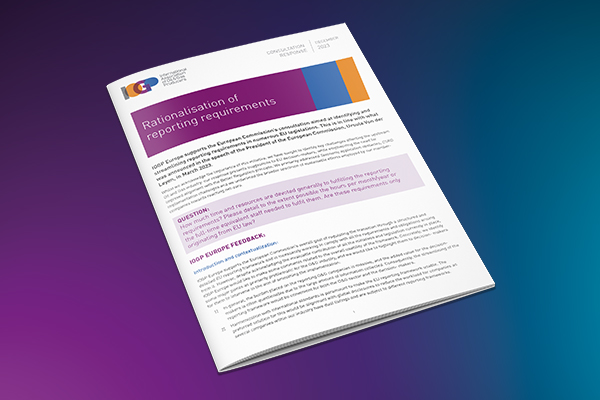
12.12.2023
Consultation Response
IOGP consultation response: Rationalisation of reporting requirements
IOGP Europe supports the European Commission’s consultation aimed at identifying and streamlining reporting requirements in numerous EU legislations. This is in line with what was announced in the s...
Read more
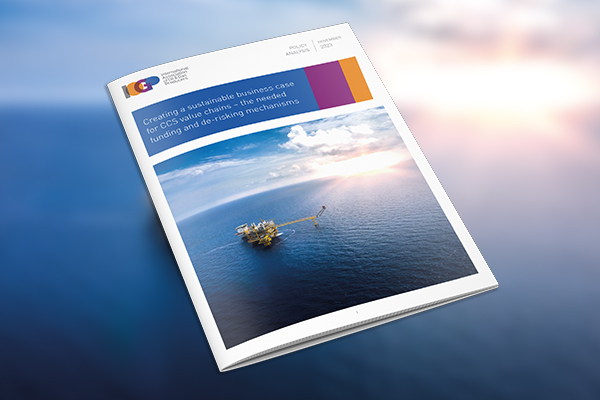
15.11.2023
Report & Study
Creating a sustainable business case for CCS value chains
This paper focuses on the discussion of needed funding and de-risking mechanisms, it describes the complex CCS value chains and its costs, describes CO2 storage project development phases, provides an...
Read more
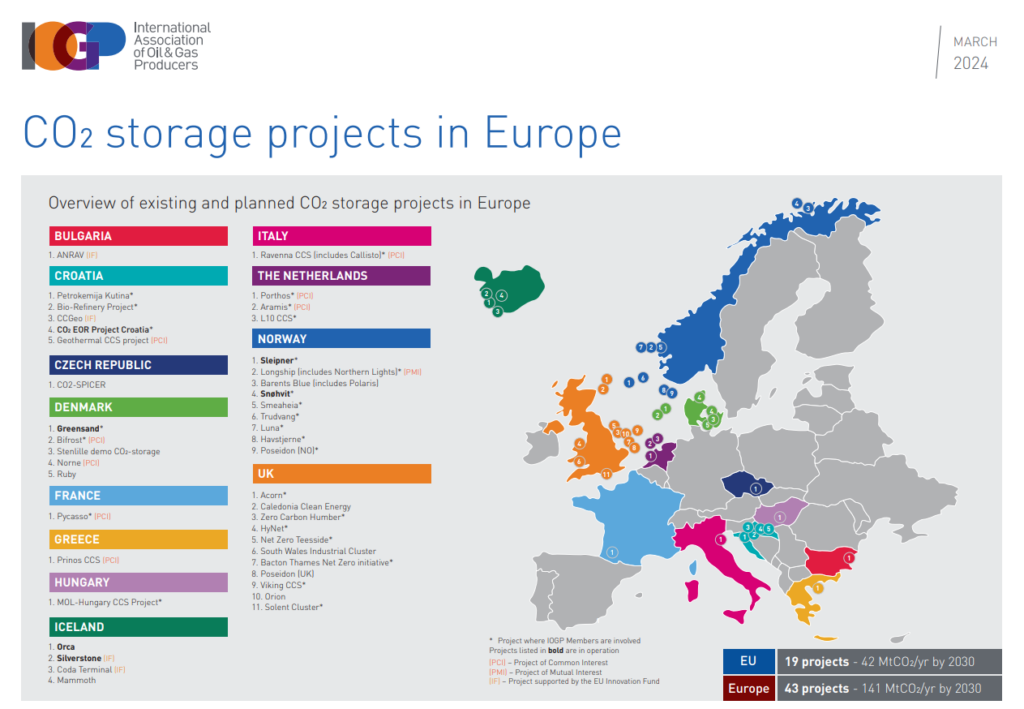
10.10.2023
Factsheet & Infographic
Map of CO2 storage Projects in Europe
An overview of existing and planned Carbon storage projects in Europe with the following details:
Location
Project name
Elements of CCS Value Chain covered
Type of Capture project
Des...
Read more
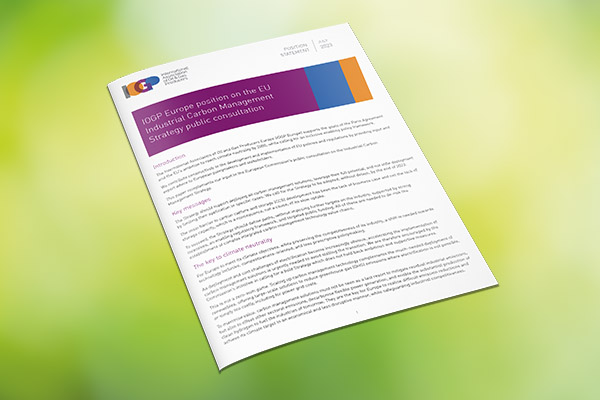
17.08.2023
Position Paper
IOGP Europe position on the EU Industrial Carbon Management
IOGP Europe supports the goals of the Paris Agreement and the EU’s ambition to reach climate neutrality by 2050, while calling for an inclusive enabling policy framework. We contribute constructivel...
Read more
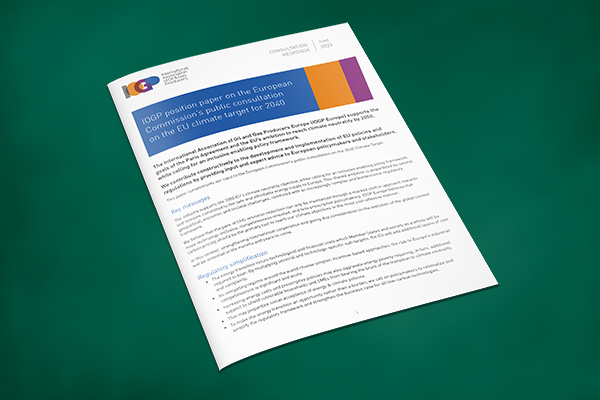
22.06.2023
Consultation Response
IOGP position paper on the European Commission’s public consultation on the EU climate target for 2040
Our industry supports the 2050 EU’s climate neutrality objective, while calling for an inclusive enabling policy framework, and remains committed to the safe and affordable energy supply to Europe....
Read more
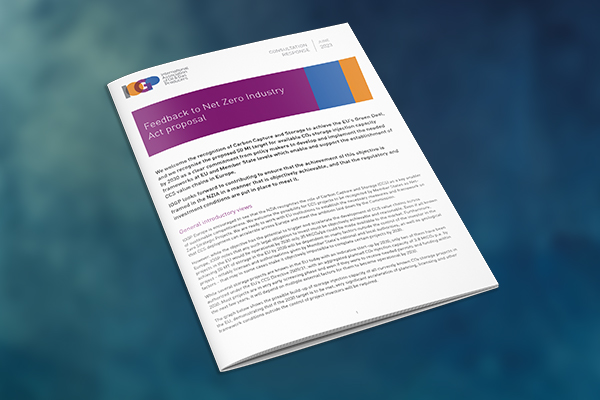
21.06.2023
Consultation Response
IOGP Europe feedback on Net Zero Industry Act proposal
This paper was developed in response to the European Commission’s call for feedback on the Net Zero Industry Act. Below is an executive summary, please download the full report here
IOGP Europe i...
Read more
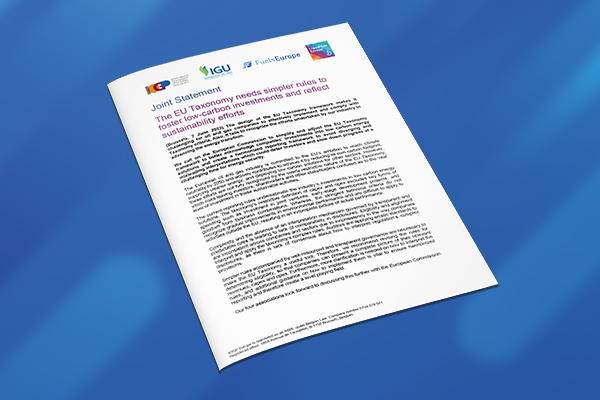
13.06.2023
Position Paper
Joint industry statement on the EU Taxonomy
The EU Taxonomy needs simpler rules to foster low-carbon investments and reflect sustainability efforts.
(Brussels, 7 June 2023) The design of the EU Taxonomy framework makes it challenging for oil a...
Read more
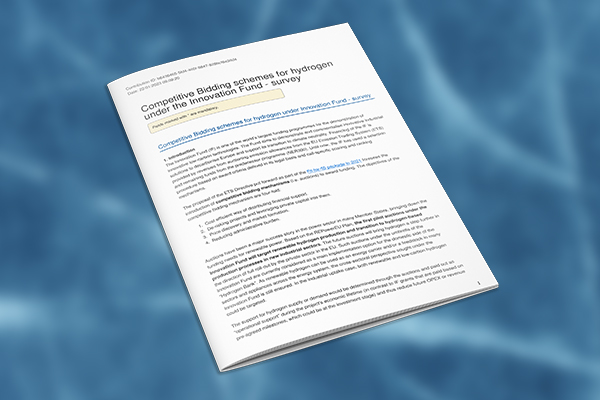
25.01.2023
Consultation Response
IOGP response on Competitive Bidding schemes for hydrogen under the Innovation Fund
This document provides IOGP's input to the public consultation (questionnaire) on Competitive Bidding schemes for hydrogen under the Innovation Fund.
Background
The Innovation Fund (IF) is one of th...
Read more
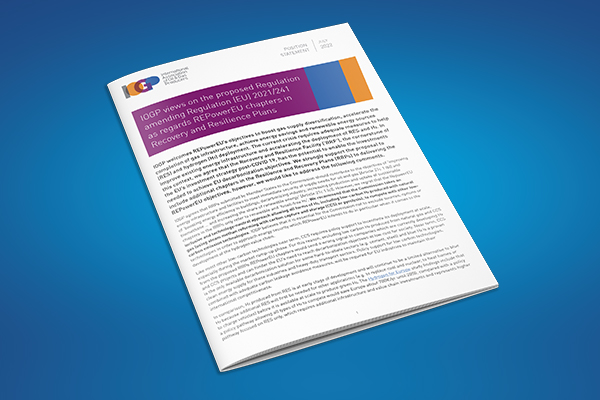
29.07.2022
Position Paper
IOGP views on the proposed Regulation amending Regulation (EU) 2021/241 as regards REPowerEU chapters in Recovery and Resilience Plans
This document provides IOGP's views on the proposed Regulation amending Regulation (EU) 2021/241 as regards REPowerEU chapters in Recovery and Resilience Plans.
Context
IOGP welcomes REPowerEU’s o...
Read more
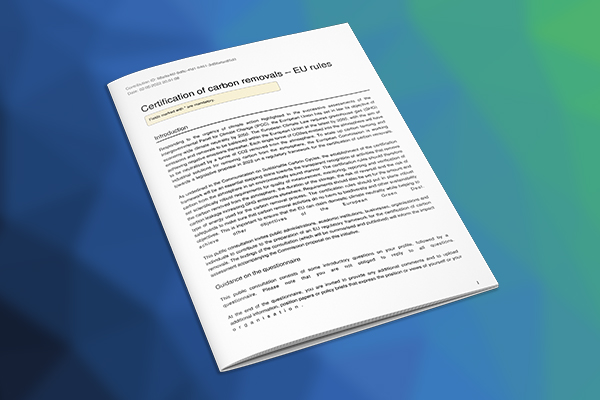
16.05.2022
Consultation Response
IOGP response to the consultation on certification of carbon removals – EU rules
This document provides IOGP’s input to the EU public consultation (questionnaire) on the certification of carbon removals – EU rules.
IOGP supports the development of certification of carbon re...
Read more
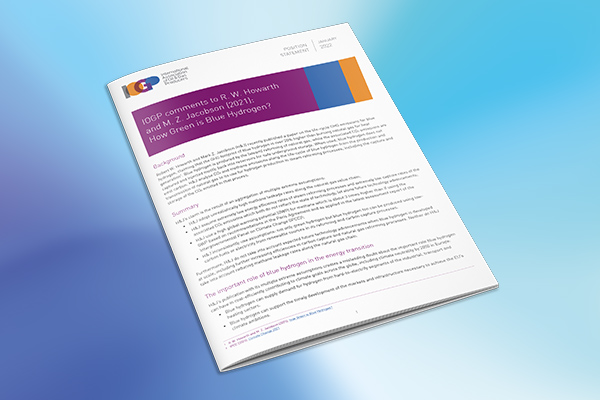
31.01.2022
Position Paper
IOGP comments to R. W. Howarth and M. Z. Jacobson (2021): How Green is Blue Hydrogen?
This document provides IOGP’s comments on Howarth and Jacobson’s publication (2021) 'How Green is Blue Hydrogen?'.
Backgroud
Robert W. Howarth and Mark Z. Jacobson (H&J) recently published...
Read more
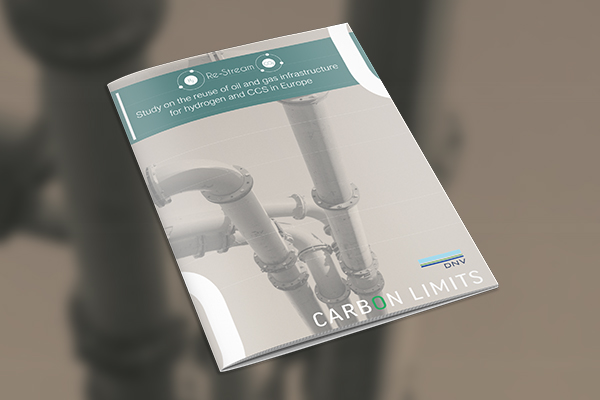
28.10.2021
Re-Stream – Study on the reuse of oil and gas infrastructure for hydrogen and CCS in Europe
The Re-Stream cross-industry study provides fact-based elements on the reuse of oil and gas infrastructure by identifying and assessing relevant infrastructure, and defining which technical adap...
Read more
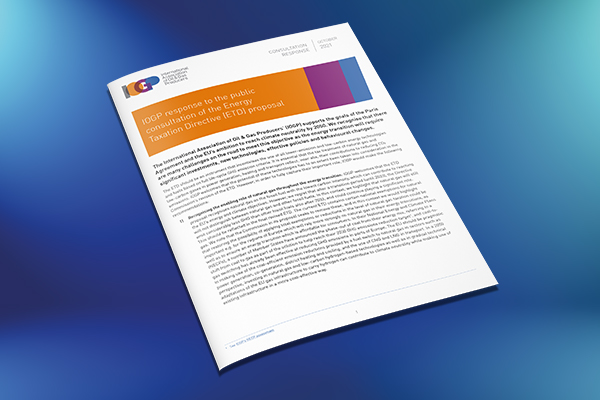
19.10.2021
Consultation Response
IOGP response to the public consultation on the Energy Taxation Directive (ETD) proposal
This document provides IOGP’s response to the EU public consultation on the Energy Taxation Directive (ETD) proposal.
Context
The ETD should be an instrument...
Read more
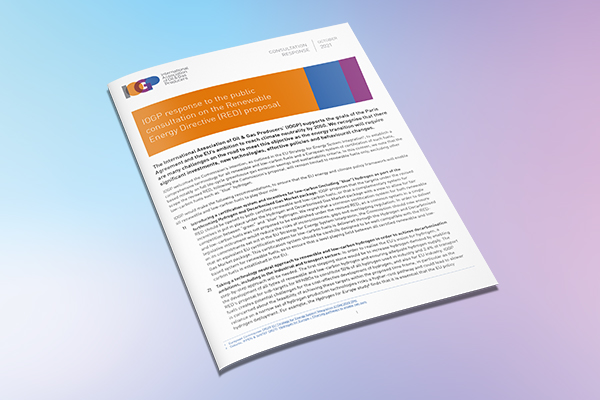
19.10.2021
Consultation Response
IOGP response to the public consultation on the Renewable Energy Directive (RED) proposal
This document provides IOGP’s response to the EU public consultation on the Renewable Energy Directive (RED) proposal.
Context
IOGP welcomed the Commission’...
Read more
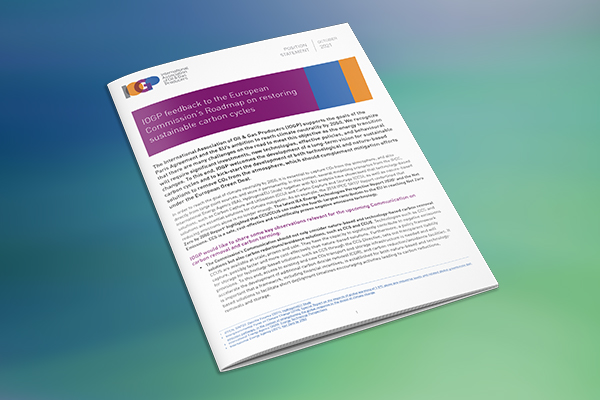
19.10.2021
IOGP feedback to the European Commission’s Roadmap on restoring sustainable carbon cycles
This document provides IOGP’s feedback to the to the European Commission’s Roadmap on restoring sustainable carbon cycles.
Context
The initiative aims to su...
Read more
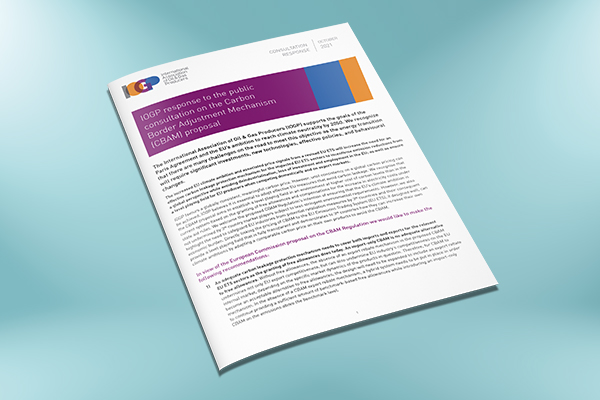
19.10.2021
Consultation Response
IOGP response to the public consultation on the Carbon Border Adjustment Mechanism (CBAM) proposal
This document provides IOGP’s response to the EU public consultation on the Carbon Border Adjustment Mechanism (CBAM) proposal.
Context
The increased EU clima...
Read more
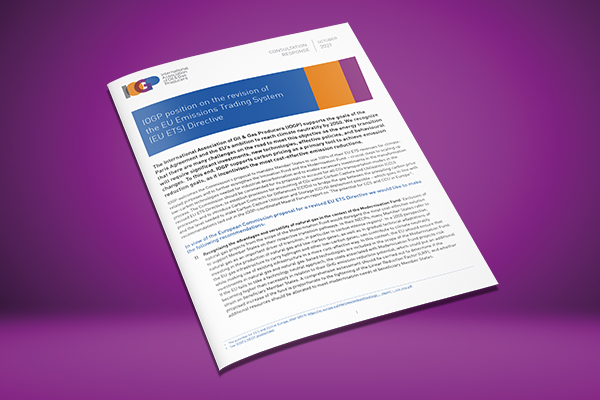
18.10.2021
Consultation Response
IOGP position on the revision of the EU Emissions Trading System (EU ETS) Directive
This document provides IOGP’s response to the EU public consultation on the revision of the EU Emissions Trading System (EU ETS) Directive.
Context
IOGP welco...
Read more
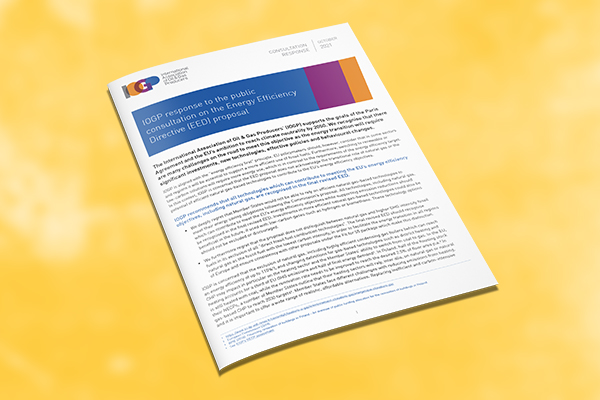
18.10.2021
Consultation Response
IOGP response to the public consultation on the Energy Efficiency Directive (EED) proposal
This document provides IOGP’s response to the EU public consultation on the Energy Efficiency Directive (EED) proposal.
Context
IOGP is aligned with the “en...
Read more

19.09.2021
Consultation Response
IOGP response to the public consultation on the FuelEU Maritime proposal
This document provides IOGP’s response to the EU public consultation on the FuelEU Maritime proposal.
Context
IOGP welcomes the proposed FuelEU Maritime Regul...
Read more

14.07.2021
Position Paper
IOGP Paper on metric to use for 2030 targets
This document provides IOGP’s recommendations on the metric to be used for the EU 2030 gas decarbonization targets.
Context
The EU is implementing mea...
Read more
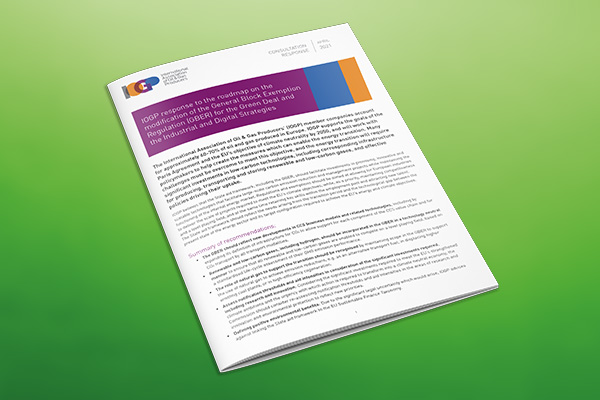
21.04.2021
Consultation Response
IOGP response to the roadmap on the modification of the General Block Exemption Regulation (GBER)
This document provides IOGP’s response to the roadmap on the modification of the General Block Exemption Regulation (GBER) for the Green Deal and the Industrial and Digital Strategies.
&nb...
Read more
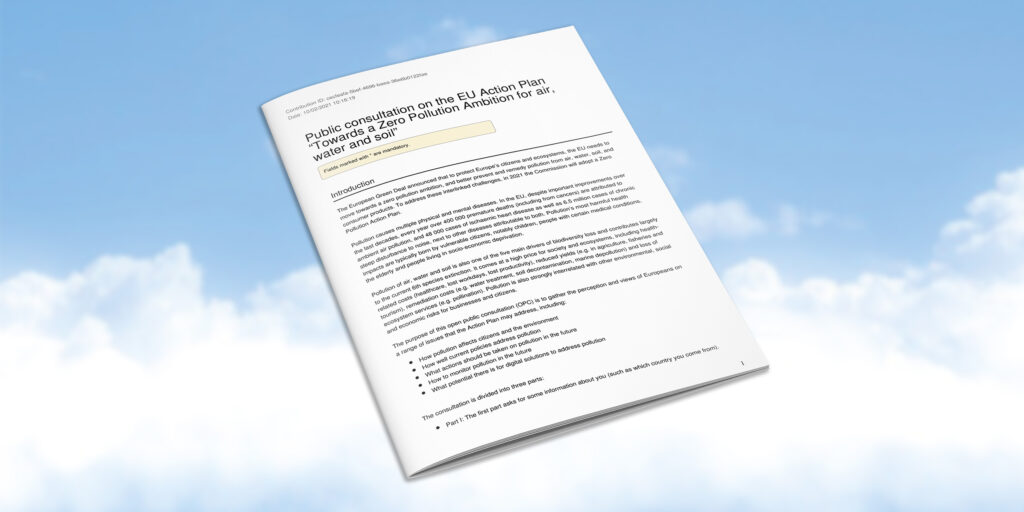
12.02.2021
Consultation Response
Public consultation on the EU Action Plan “Towards a Zero Pollution Ambition for air, water and soil”
This document provides IOGP’s response to the EU public consultation on the EU Action Plan “Towards a Zero Pollution Ambition for air, water and soil”.
The purpose of this open public c...
Read more
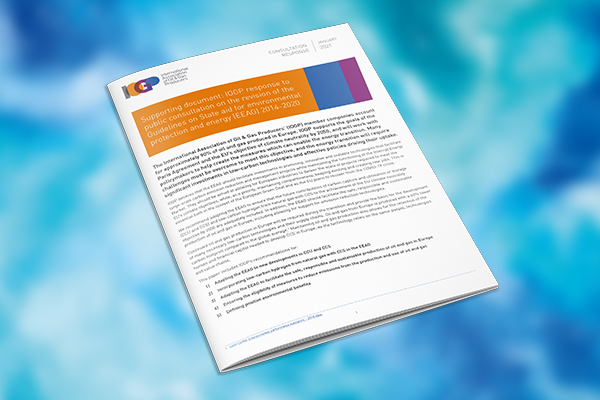
01.02.2021
Consultation Response
IOGP response to consultation on the revision of the Guidelines on State aid for environmental protection and energy (EEAG)
This paper provides IOGP’s contribution to the EU public consultation (questionnaire) on the revision of the Guidelines on State aid for environmental protection and energy (EEAG) 2014-2020 an...
Read more

17.12.2020
Consultation Response
IOGP response to the Inception Impact Assessment on the revision of the Guidelines on State aid for environmental protection and energy (EEAG) 2014-2020
This document provides IOGP’s response to the Inception Impact Assessment (IIA) on the revision of the Guidelines on State aid for environmental protection and energy (EEAG) 2014-2020.
&nbs...
Read more
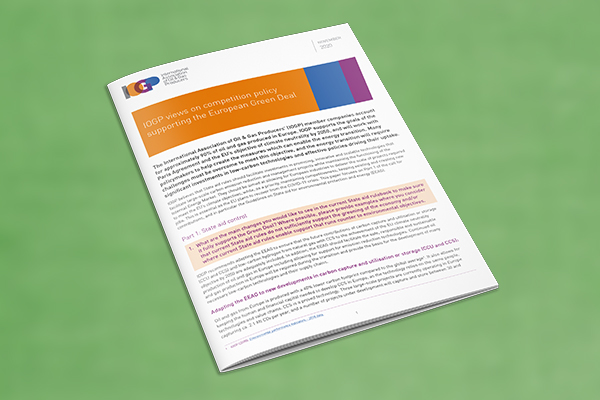
04.12.2020
Position Paper
IOGP views on competition policy supporting the European Green Deal
The Commission adopted the current guidelines on State aid for environmental protection and energy measures in 2014 as part of its modernisation agenda. The guidelines will be revised against th...
Read more
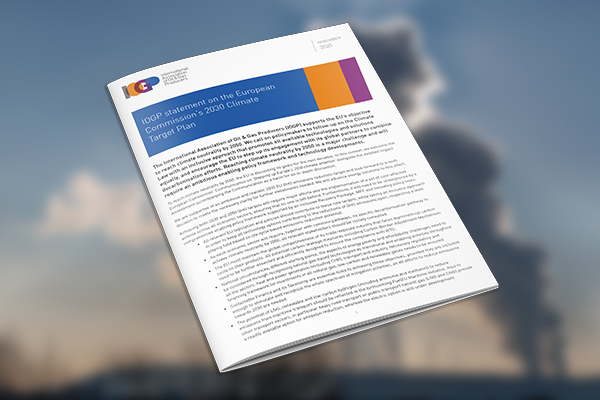
25.11.2020
Position Paper
IOGP statement on the European Commission’s 2030 Climate Target Plan
This document provides IOGP’s views on the European Commission’s 2030 Climate Target Plan.
IOGP calls on policymakers to follow up on the Climate Law with an inclusive approach that promo...
Read more
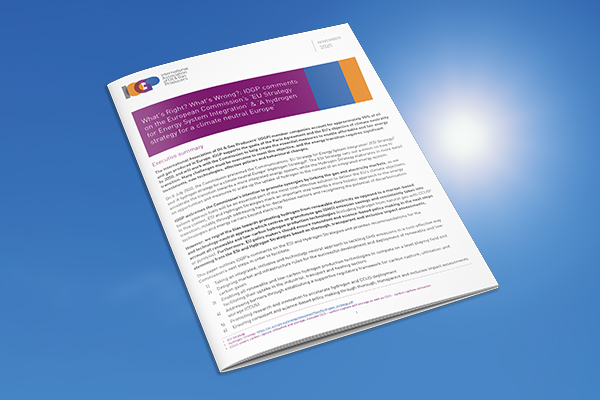
17.11.2020
Position Paper
What’s Right? What’s Wrong? IOGP comments on the ‘EU Strategy for Energy System Integration’ and ‘A hydrogen strategy for a climate neutral Europe’
On 8 July 2020, the Commission presented the Communications ‘EU Strategy for Energy System Integration’ (ESI Strategy) and ‘A hydrogen strategy for a climate neutral Europe’ (Hydrogen St...
Read more
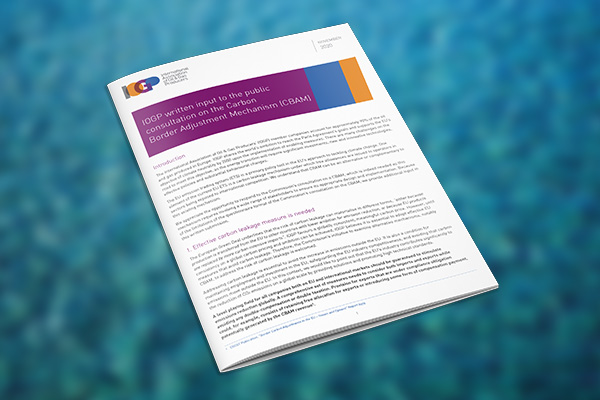
02.11.2020
Consultation Response
IOGP written input to the public consultation on the Carbon Border Adjustment Mechanism (CBAM)
This document provides IOGP’s written input to the Commission’s public consultation on the Carbon Border Adjustment Mechanism (CBAM)
The EU emission trading system (ETS) is a primary poli...
Read more
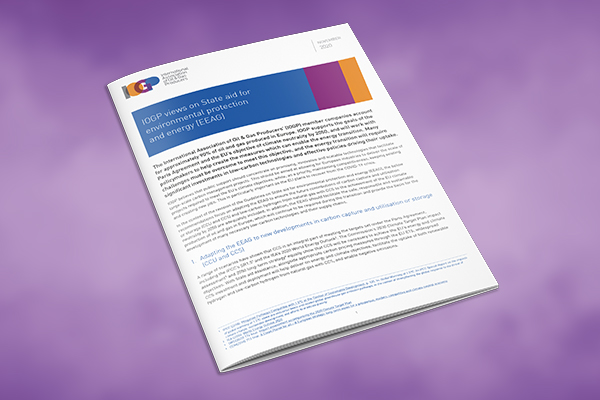
02.11.2020
Position Paper
IOGP views on State aid for environmental protection and energy (EEAG)
This document provides IOGP’s views on the State aid for environmental protection and energy (EEAG) .
IOGP’s recommendations focus on adapting the EEAG to ensure the future contributions...
Read more
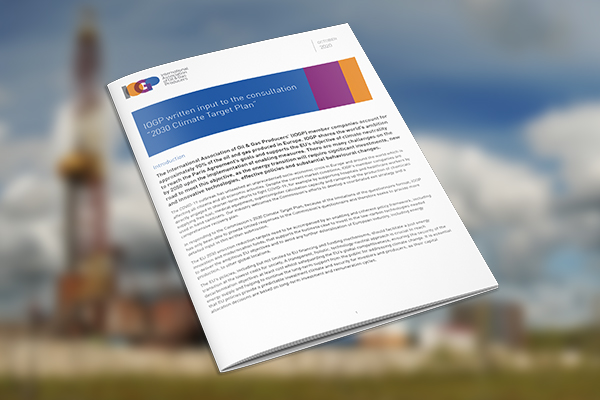
13.10.2020
Consultation Response
IOGP written input to the consultation “2030 Climate Target Plan”
This document provides IOGP’s written input to the consultation “2030 Climate Target Plan” which ended on 23 June 2020.
The EU 2030 emission reduction targets need to be accompanied by...
Read more
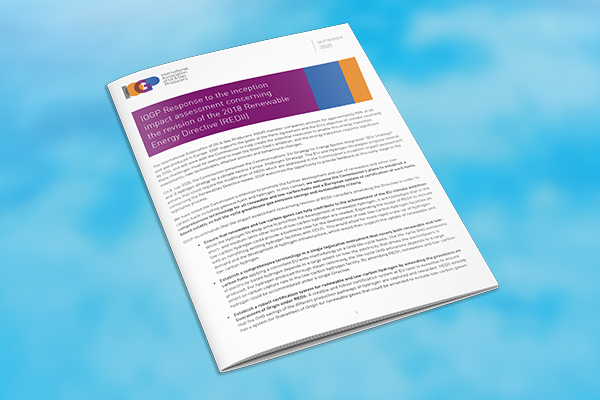
25.09.2020
Consultation Response
IOGP response to the inception impact assessment concerning the revision of the 2018 Renewable Energy Directive (REDII)
This document provides IOGP’s response to the inception impact assessment concerning the revision of the 2018 Renewable Energy Directive (REDII).
IOGP welcomes the European Commission’s p...
Read more
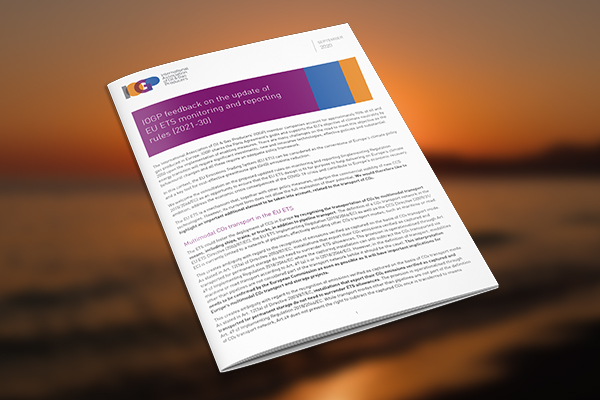
04.09.2020
Consultation Response
IOGP feedback on the update of EU ETS monitoring and reporting rules (2021-30)
This document provides IOGP’s feedback on update of EU Emissions Trading System (ETS) monitoring and reporting rules (2021-30).
Context
The EU...
Read more
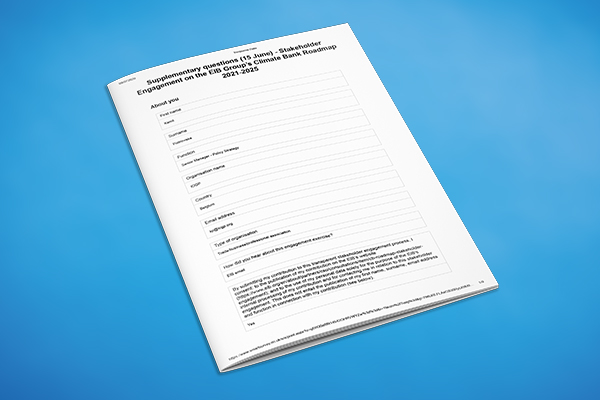
24.07.2020
Consultation Response
IOGP response to supplementary questions on the EIB Group’s Climate Bank Roadmap 2021-2025
This document provides IOGP’s response to the Stakeholder engagement on the EIB Group’s Climate Bank Roadmap 2021-2025.
IOGP recommends the EIB Group to set the financial support framewor...
Read more

23.07.2020
Consultation Response
IOGP response to consultation on the renewed Sustainable Finance strategy
This document provides IOGP’s response to the consultation on the renewed Sustainable Finance strategy.
The response to the consultation is sent through an online questionna...
Read more
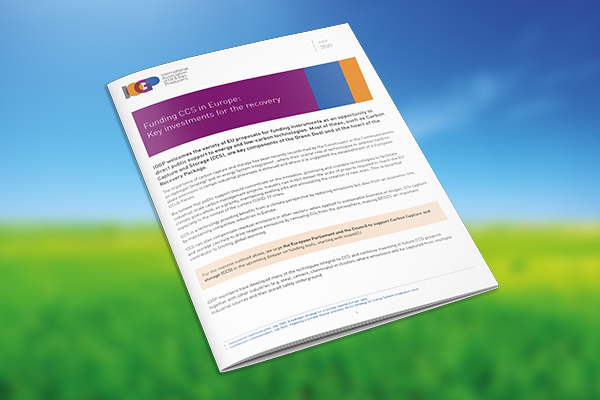
23.07.2020
Report & Study
Funding CCS in Europe: key investments for the recovery
This document outlines the main reasons why investing in Carbon Capture and Storage (CCS) is key for the recovery.
IOGP welcomes the variety of EU proposals for funding instruments as an oppo...
Read more
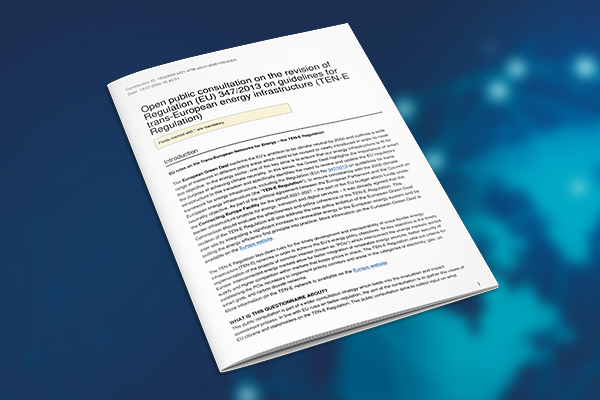
20.07.2020
Consultation Response
IOGP response to the public consultation on the revision of Regulation (EU) 347/2013 on guidelines for TEN-E Regulation
This document provides IOGP’s contribution to the public consultation on the revision of Regulation (EU) 347/2013 on guidelines for trans-European energy infrastructure (TEN-E Regulation)....
Read more
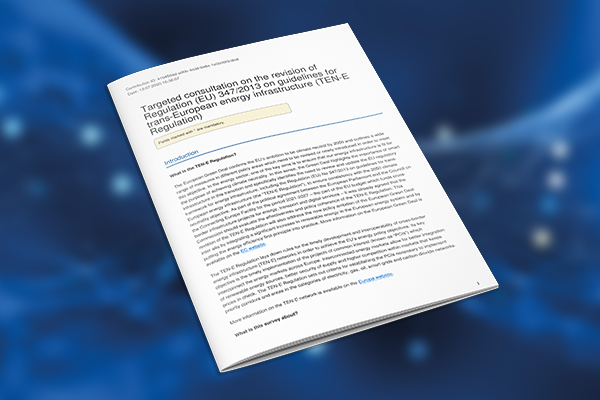
20.07.2020
Consultation Response
IOGP response to targeted consultation on the revision of Regulation (EU) 347/2013 on guidelines for TEN-E Regulation
This document provides IOGP’s response to the targeted consultation on the revision of Regulation (EU) 347/2013 on guidelines for trans-European energy infrastructure (TEN-E Regulation).
Th...
Read more
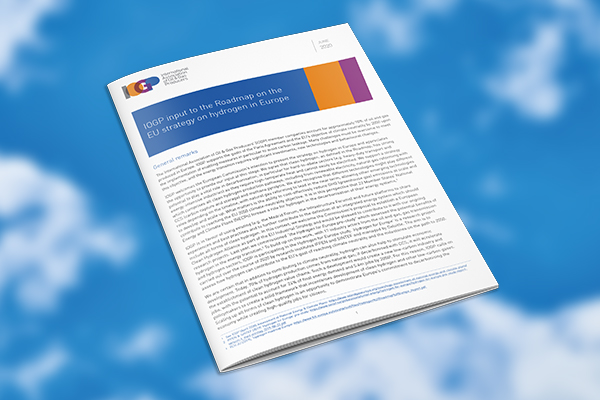
17.06.2020
Consultation Response
IOGP input to the Roadmap on the EU strategy on hydrogen in Europe
This document provides IOGP’s input and policy recommendations to the Roadmap on the EU strategy on hydrogen in Europe.
Clean hydrogen has strong potential to play a vital role in decarboni...
Read more

16.06.2020
Consultation Response
IOGP feedback to the Combined Evaluation Roadmap/Inception Impact Assessment on the revision of Regulation (EU) 347/2013 on guidelines for TEN-E
This document provides IOGP’s initial feedback on the upcoming review of the Regulation on guidelines for Trans-European Energy Infrastructure (TEN-E) and related policy recommendations.
In...
Read more
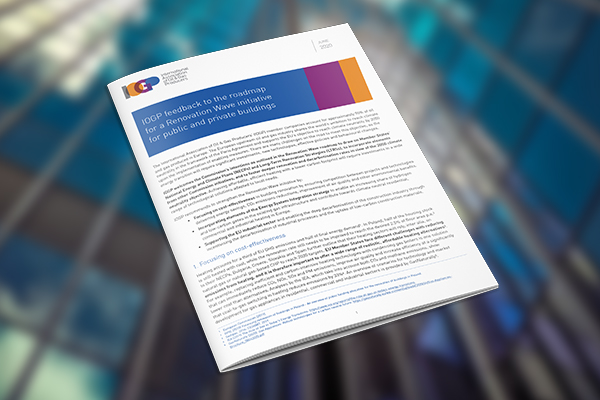
11.06.2020
Consultation Response
IOGP feedback to the roadmap for a Renovation Wave initiative for public and private buildings
This document outlines IOGP’s feedback to the roadmap for a Renovation Wave initiative for public and private buildings.
IOGP welcomes the Commission’s intentions to draw on Member States...
Read more
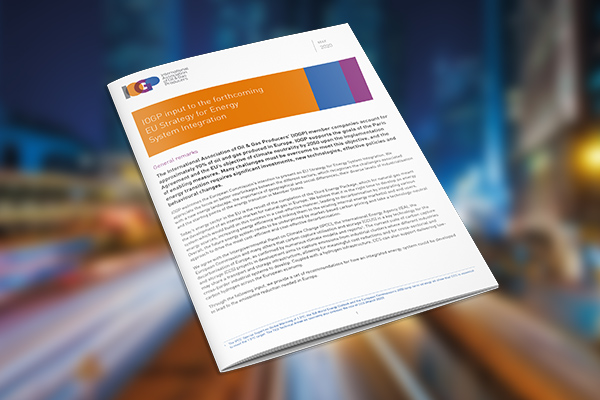
25.05.2020
Consultation Response
IOGP input to the forthcoming EU Strategy for Energy System Integration
This document outlines IOGP’s input to the forthcoming EU Strategy for Energy System Integration.
Today’s energy sector in the EU is the result of the completion of the Third Energy Packa...
Read more
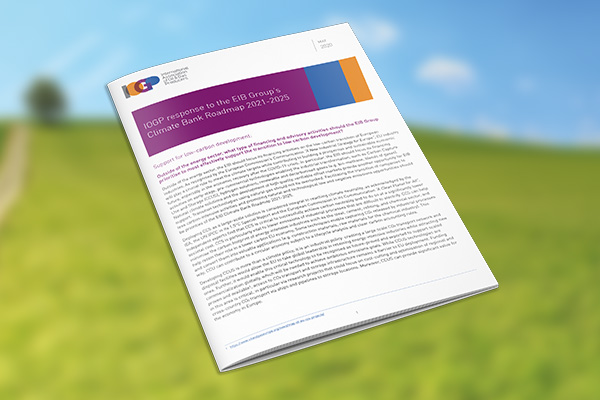
08.05.2020
Consultation Response
IOGP response to the EIB Group’s Climate Bank Roadmap 2021-2025
This document provides IOGP’s response to the EIB Group’s Climate Bank Roadmap 2021-2025.
IOGP recommends the EIB Group to set the financial support framework for innovative projects (inc...
Read more

06.05.2020
Consultation Response
Input to the inception impact assessment on the FuelEU Maritime
This document provides IOGP’s input to the inception impact assessment on the FuelEU Maritime.
IOGP’s response focuses on liquefied natural gas (LNG) and hydrogen as these technologies co...
Read more
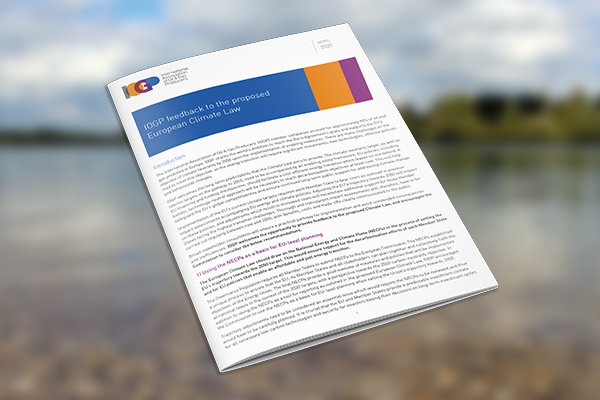
04.05.2020
Consultation Response
IOGP feedback to the proposed European Climate Law
This document provides IOGP’s feedback to the proposed Climate Law.
IOGP welcomes the long-term predictability that the Climate Law aims to provide.
The climate neutrality target, as wel...
Read more

30.04.2020
Consultation Response
Feedback to the impact inception assessment “2030 Climate Target Plan”
This document provides IOGP’s initial feedback to the Impact Inception Assessment “2030 Climate Target Plan”.
The EU 2030 and 2050 GHG reduction targets need to be accompanied by an ena...
Read more
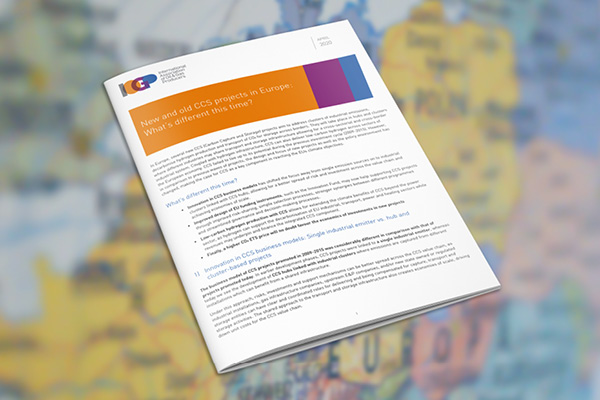
21.04.2020
Report & Study
New and old CCS projects in Europe: What’s different this time?
This paper outlines the key changes in CCS projects compared to the previous investment cycle (2009-2015). It highlights what is different this time in terms of regulatory context and the develo...
Read more
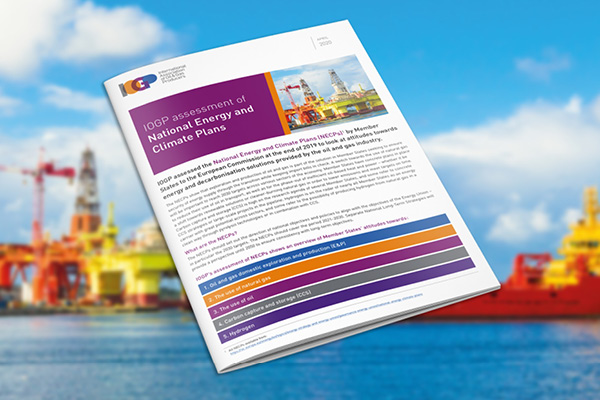
14.04.2020
Factsheet & Infographic
IOGP assessment of National Energy and Climate Plans
EU Member States’ National Energy and Climate Plans (NECPs) should set out the direction of national objectives and policies to align with the objectives of the Energy Union, in particular the...
Read more
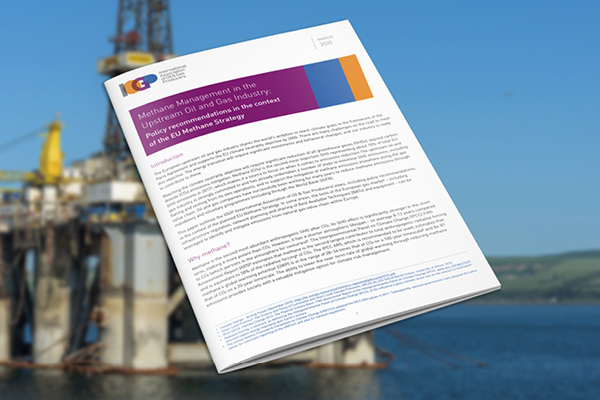
08.04.2020
Position Paper
Methane Management in the Upstream Oil and Gas Industry: Policy recommendations in the context of the EU Methane Strategy
Brief Description
The paper outlines IOGP’s views and policy recommendations in the context of the planned EU Methane Strategy.
The document represents IOGP’s i...
Read more

25.02.2020
Factsheet & Infographic
Scaling up Hydrogen in Europe
This factsheet gives an overview of hydrogen and its potential in Europe:
Applications across sectors
The potential of CCS applied to hydrogen production
Hydrogen production
Policy recom...
Read more
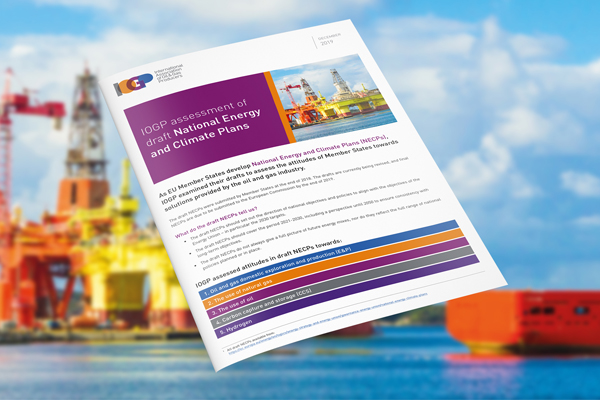
25.12.2019
Factsheet & Infographic
IOGP assessment of draft National Energy and Climate Plans
EU Member States developed and submitted their draft National Energy and Climate Plans (NECPs) at the end of 2018. Drafts were revised in 2019.
The factsheet shows IOGP assessments of the Member St...
Read more
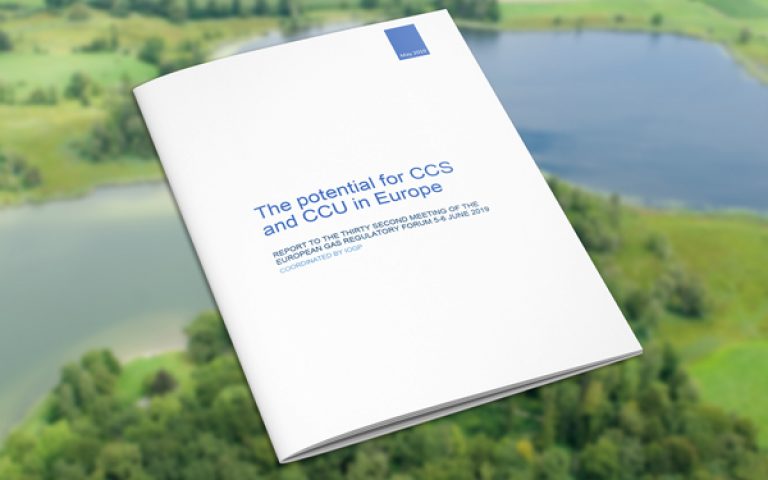
10.05.2019
Report & Study
The potential for CCS and CCU in Europe Report to the thirty second meeting of the European Gas Regulatory Forum 5-6 June 2019
The 31st Madrid Forum invited IOGP to coordinate a report on the potential of Carbon Capture and Storage (CCS) and Carbon Capture and Utilisation (CCU) technologies, including technical, economi...
Read more

10.07.2018
Factsheet & Infographic
LNG – a fast lane to make Europe a leader in clean shipping
An overview of Liquified Natural Gas (LNG) and its application in Europe for clean shipping:
Challenges ahead
Advantages of choosing LNG
Policy recommendations for the EU...
Read more
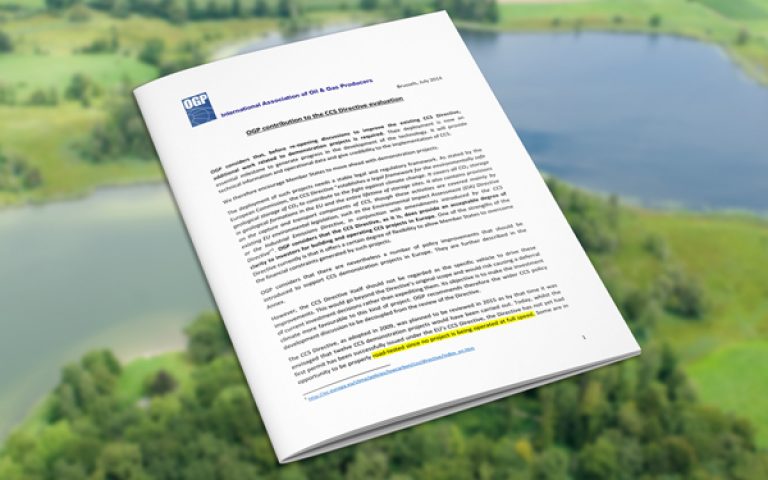
10.06.2014
Position Paper
OGP contribution to the CCS Directive evaluation
The paper presents IOGP’s views on the role of CCS and some features to be taken into consideration for building a well-functioning Innovation Fund.
The document also highlights some key te...
Read more
29.02.2024
News
IOGP Europe joined BusinessEurope in industrial permitting task force
Brussels, 29 February 2024
IOGP Europe was invited by BusinessEurope to participate in a task force created to analyse processes for industrial permitting in the EU.
Throughout 2023, I...
Read more
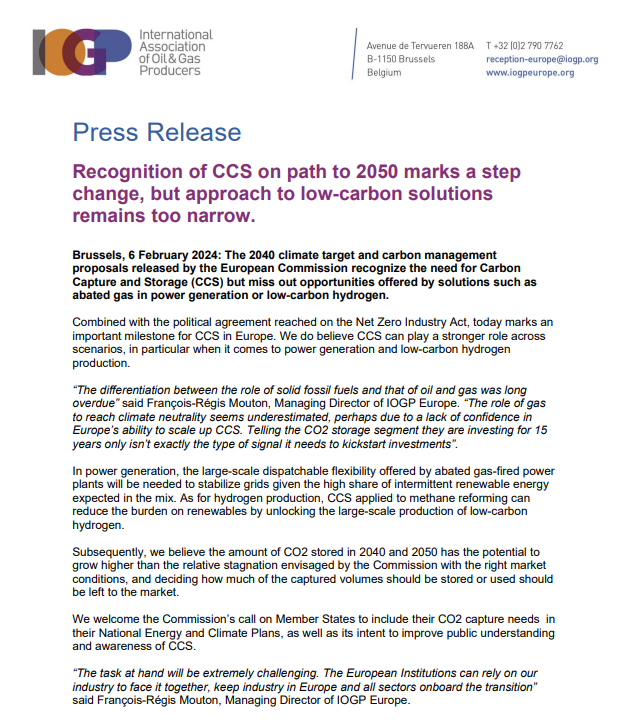
06.02.2024
Press Release
Press release: Recognition of CCS on path to 2050 marks a step change, but approach to low-carbon solutions remains too narrow.
Brussels, 6 February 2024: The 2040 climate target and carbon management proposals released by the European Commission recognize the need for Carbon Capture and Storage (CCS) but miss out opportunitie...
Read more
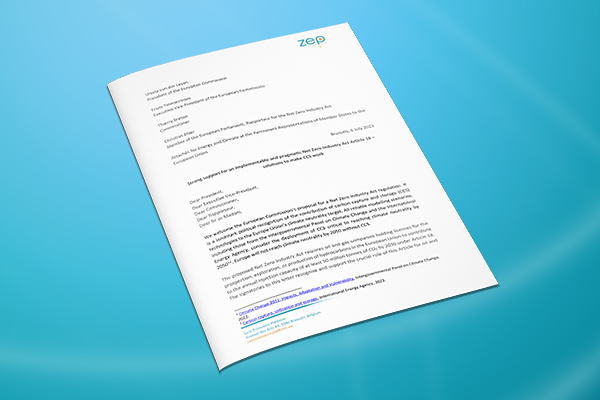
06.07.2023
Letter to Officials
Letter: Strong support for an implementable and pragmatic Net Zero Industry Act Article 18 – solutions to make CCS work
Ursula von der Leyen
President of the European Commission
Frans Timmermans
Executive Vice-President of the European Commission
Thierry Breton
Commissioner
Christian Ehler
Member of the Eu...
Read more
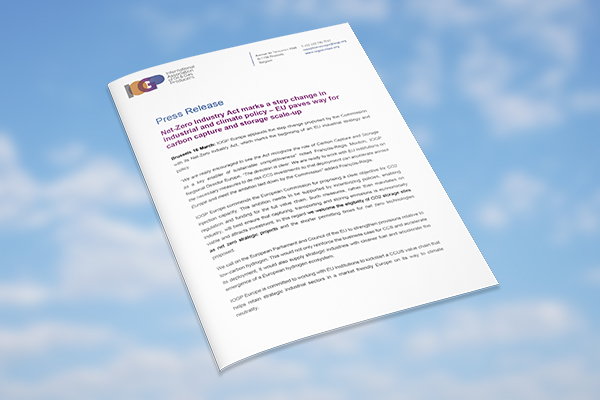
16.03.2023
Press Release
Net-Zero Industry Act marks a step change in industrial and climate policy – EU paves way for carbon capture and storage scale-up
Brussels, 16 March 2023
IOGP Europe applauds the step change proposed by the Commission with its Net-Zero Industry Act, which marks the beginning of an EU industrial strategy and policy.
“We a...
Read more

01.02.2023
Letter to Officials
Letter: Open, inclusive, and pragmatic Green Deal Industrial Plan for Europe
To: Ms Ursula von der Leyen, President of the European Commission
Brussels, 31 January 2023
Dear President,
We are writing to express our support and appreciation to the Green Deal Industrial Plan...
Read more
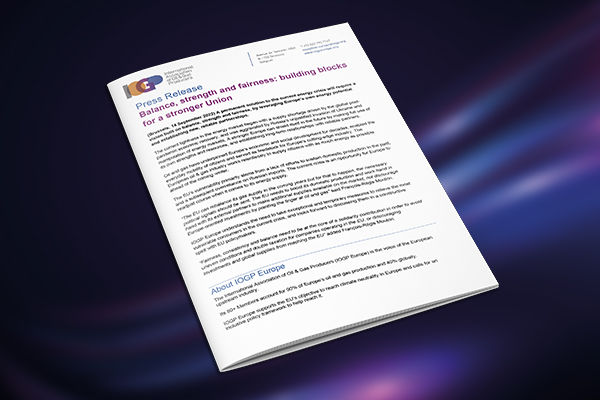
14.09.2022
Press Release
Balance, strength and fairness: building blocks for a stronger Union
Brussels, 14 September 2022
A permanent solution to the current energy crisis will require a vision built on balance, strength and fairness, by leveraging Europe’s own energy potential and establ...
Read more
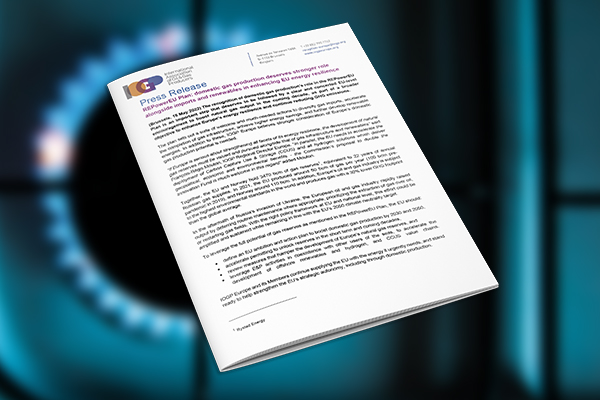
18.05.2022
Press Release
REPowerEU Plan: domestic gas production deserves stronger role alongside imports and renewables in enhancing EU energy resilience
Brussels, 18 May 2022
The recognition of domestic gas production’s role in the REPowerEU Plan is an important step that deserves to be followed by a clear and concerted EU-level encouragement to...
Read more
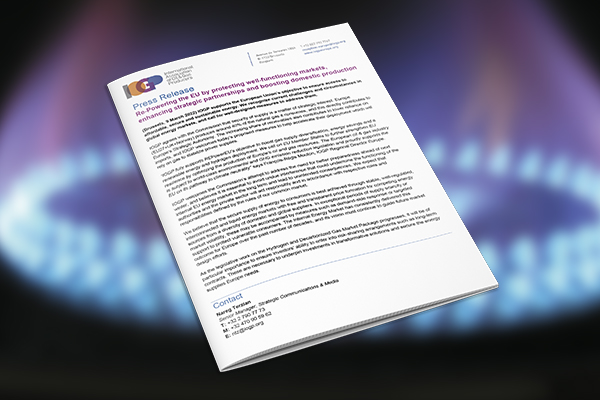
09.03.2022
Press Release
Re-Powering the EU by protecting well-functioning markets, enhancing strategic partnerships and boosting domestic production
(Brussels, 9 March 2022) IOGP supports the European Union’s objective to ensure access to affordable, secure and sustainable energy. We recognize current challenges and circumstances in global energ...
Read more
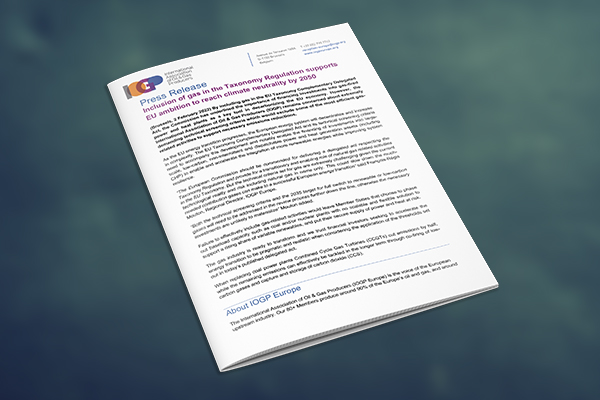
03.02.2022
Press Release
Inclusion of gas in the Taxonomy Regulation supports EU ambition to reach climate neutrality by 2050
By including gas in the EU Taxonomy Complementary Delegated Act, the Commission has underlined the importance of financing investments into gas-fired power and heat plants as a key tool in decarbonizi...
Read more
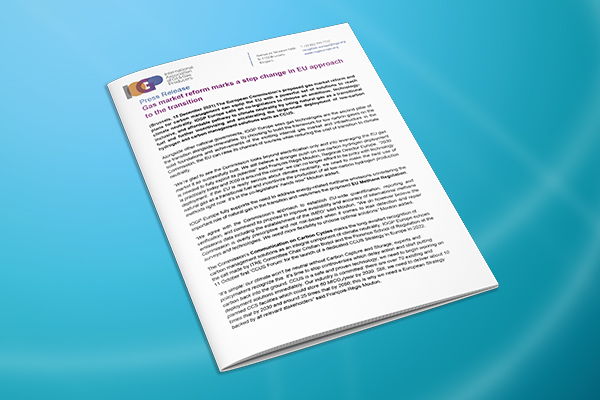
15.12.2021
Press Release
Gas market reform marks a step change in EU approach to the transition
The European Commission’s proposed gas market reform and plans for carbon management can equip the EU with a powerful set of solutions to reach climate neutrality. IOGP Europe calls on co-legi...
Read more
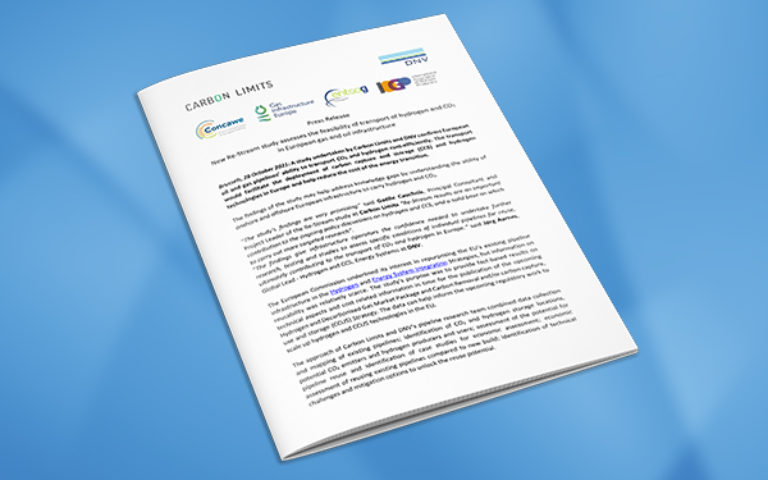
28.10.2021
Press Release
New Re-Stream study assesses the feasibility of transport of hydrogen and CO2 in European gas and oil infrastructure
A study undertaken by Carbon Limits and DNV confirms European oil and gas pipelines’ ability to transport CO2 and hydrogen cost-efficiently. The transport would facilitate the deploy...
Read more
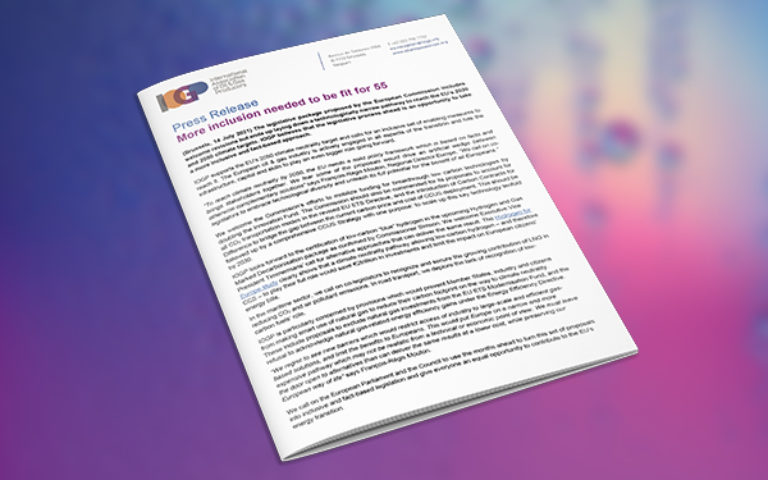
15.07.2021
Press Release
More inclusion needed to be fit for 55
Brussels, 14 July 2021
The legislative package proposed by the European Commission includes welcome revisions but ends up laying down a technologically narrow pathway to reach the EU’s 2030...
Read more
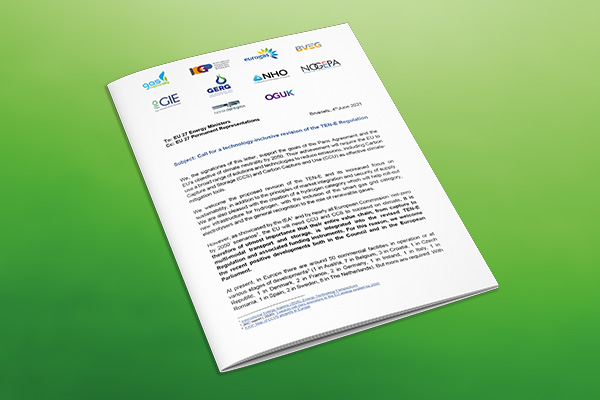
09.06.2021
Letter to Officials
Letter: Call for a technology-inclusive revision of the TEN-E Regulation
To: EU 27 Energy Ministers
Cc: EU 27 Permanent Representations
Brussels, 4th June 2021
We, the signatories of this letter, support the goals of the Paris Agreement and the EU’s ob...
Read more
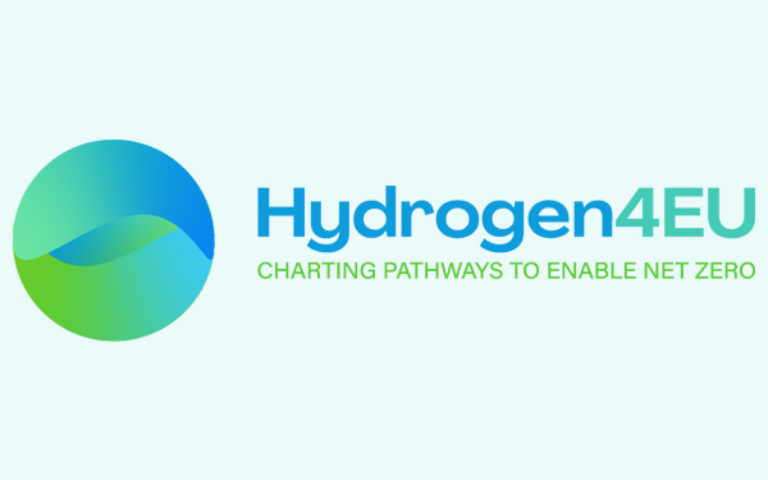
04.05.2021
News
“Hydrogen for Europe” study launch
We are proud to announce the launch of the Hydrogen for Europe study, nearly two years after its inception!
The EU’s ambition to reach climate neutrality by 2050 has recently pu...
Read more
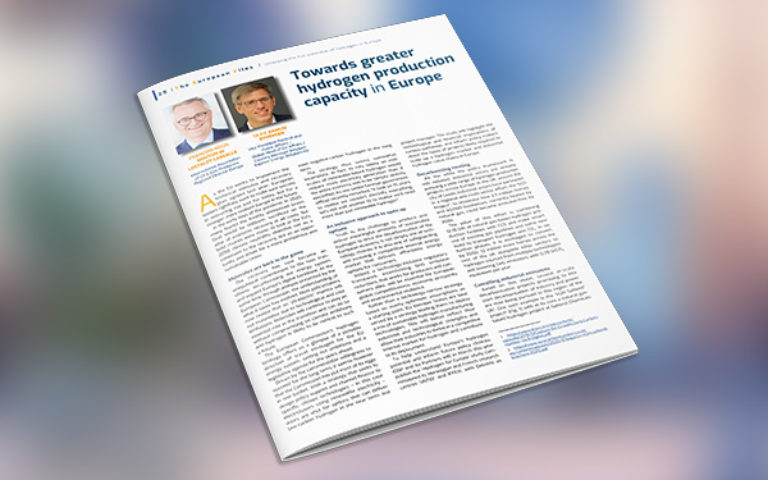
24.02.2021
News
Towards greater hydrogen production capacity in Europe
This article was originally published in the European Files, February 2021, pag.29-30
As the EU works to implement the historical stimulus and recovery plan agreed last year, European leaders...
Read more
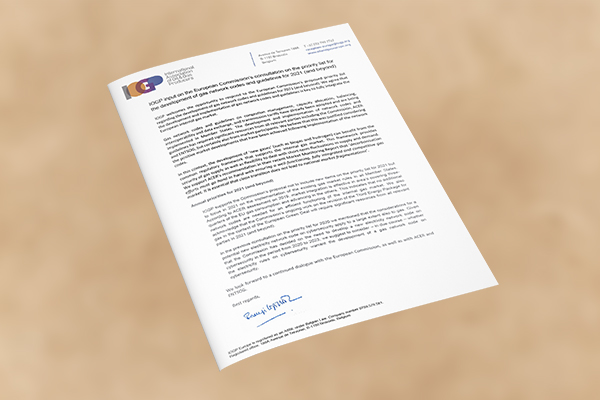
11.01.2021
Letter to Officials
Letter: IOGP input on the European Commission’s consultation on the priority list for the development of gas network codes and guidelines for 2021 (and beyond)
IOGP welcomes the opportunity to respond to the European Commission’s proposed priority list regarding the development of gas network codes and guidelines for 2021 (and beyond). We agree that...
Read more
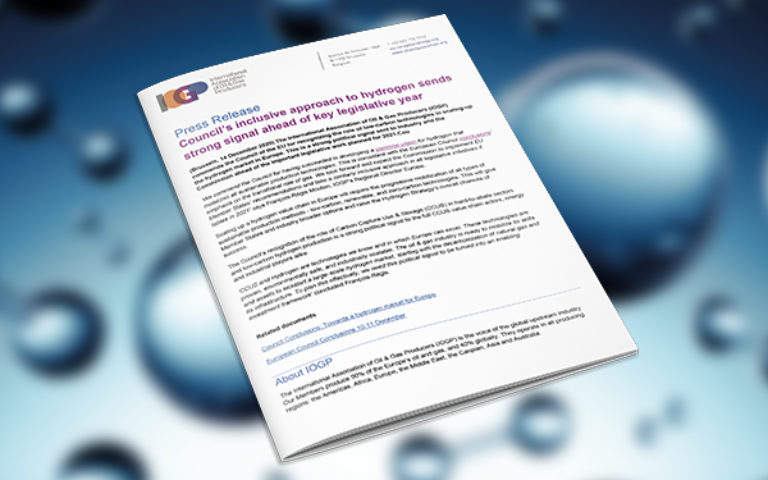
16.12.2020
Press Release
Council’s inclusive approach to hydrogen sends strong signal ahead of key legislative year
The International Association of Oil & Gas Producers (IOGP) commends the Council of the EU for recognizing the role of low-carbon technologies in scaling-up the hydrogen market in...
Read more

19.10.2020
Letter to Officials
Letter: 57 industry leaders call for enhancing gas contribution to decarbonisation
For the attention of:
Commission President Ursula von der Leyen,
President of the European Council Charles Michel,
Presidency of the Council of the EU, Minister for Economic Affairs and Ene...
Read more
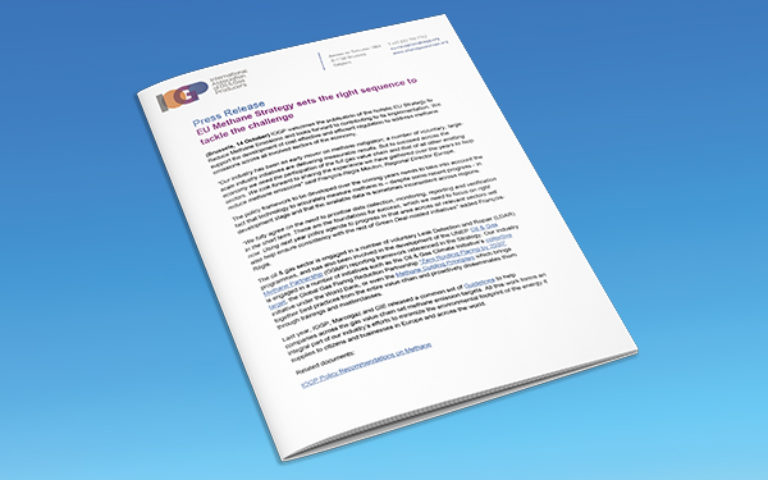
14.10.2020
Press Release
EU Methane Strategy sets the right sequence to tackle the challenge
IOGP welcomes the publication of the holistic EU Strategy to Reduce Methane Emissions and looks forward to contributing to its implementation. We support the development of cost-effective and ef...
Read more
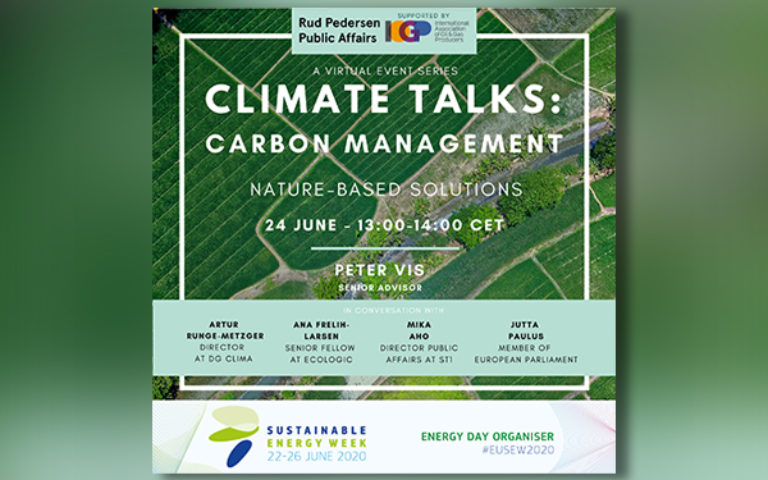
16.07.2020
News
Carbon Management Webinars
Rud Pedersen Public Affairs and IOGP organised a series of four webinars on Carbon Management – a key range of solutions of which CCS, nature-based solutions, clean hydrogen and others are a p...
Read more
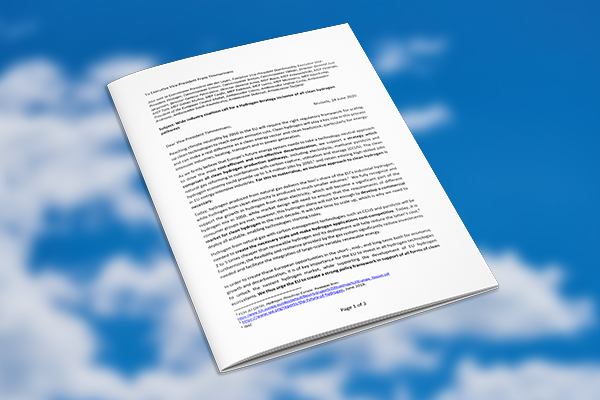
25.06.2020
Letter to Officials
Wide industry coalition call for a Hydrogen Strategy inclusive of all clean hydrogen pathways
On June 24th 2020, a wide industry coalition sent a letter to the European Commission calling for a Hydrogen Strategy inclusive of all clean hydrogen pathways.
Overview
...
Read more
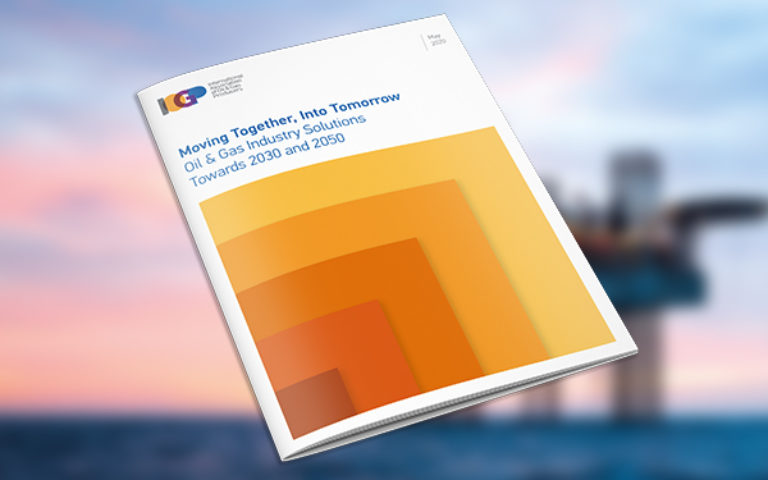
27.05.2020
News
Manifesto: Oil & Gas Industry Solutions Towards 2030 and 2050
The European upstream oil and gas industry shares the global ambition to tackle climate change in the framework of the Paris Agreement, and supports the EU’s objective to reach climate neutral...
Read more

08.05.2020
News
Climate change, purpose & doing the right thing: lessons from COVID-19
By Fawaz Bitar, Chair of IOGP
As an industry, as businesses and, most importantly, as people – this is an incredibly tough time. No matter where you are in the world, or wha...
Read more
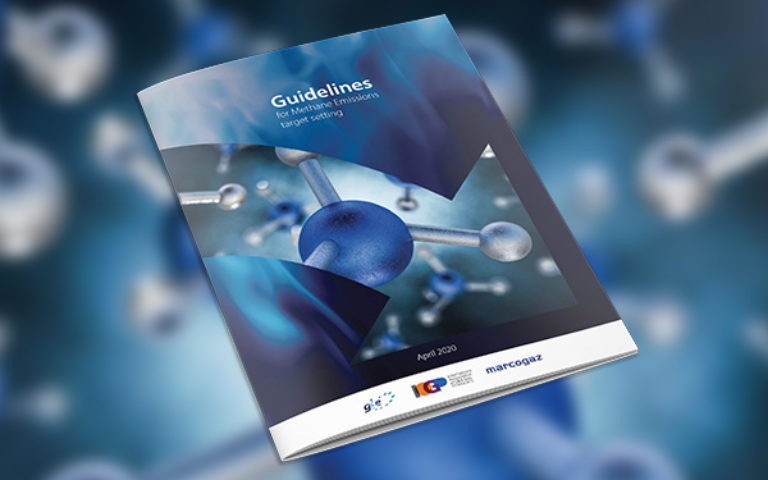
27.04.2020
Press Release
Guidelines for Methane Emissions target setting
This document analyses the state of play on GHG emissions reduction targets making use of a questionnaire circulated among GIE, IOGP and MARCOGAZ’s member companies. It gives some insights on...
Read more
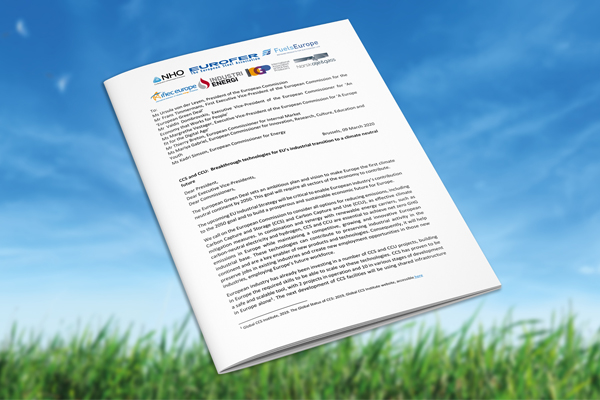
09.03.2020
Letter to Officials
Joint letter: CCS and CCU for the EU’s Industrial Transition
Ahead of the publication of the EU’s Industrial Strategy, a group of trade associations including IOGP issued a joint call for the Commission to make Carbon Capture Use & Storage an integr...
Read more
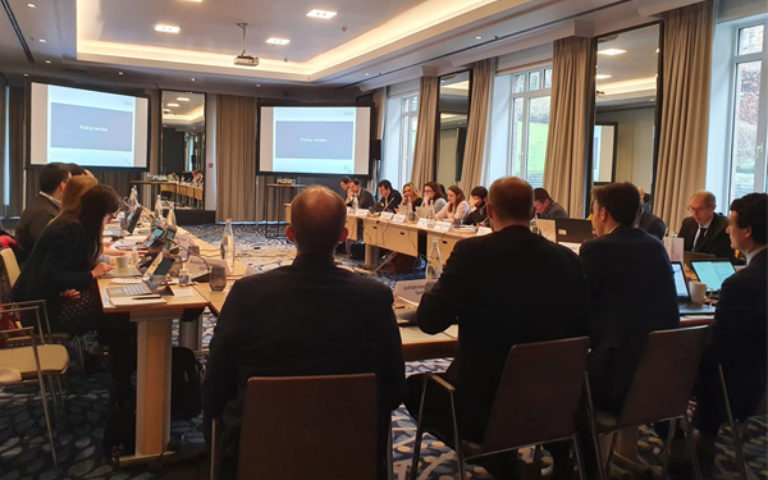
05.03.2020
News
Hydrogen for Europe: 1st Working Group Meeting
On 5 March, the “Hydrogen for Europe” study’s funding partners and research consortium met for first inception working group.
The all-day long meeting was organised in two main sections on sc...
Read more
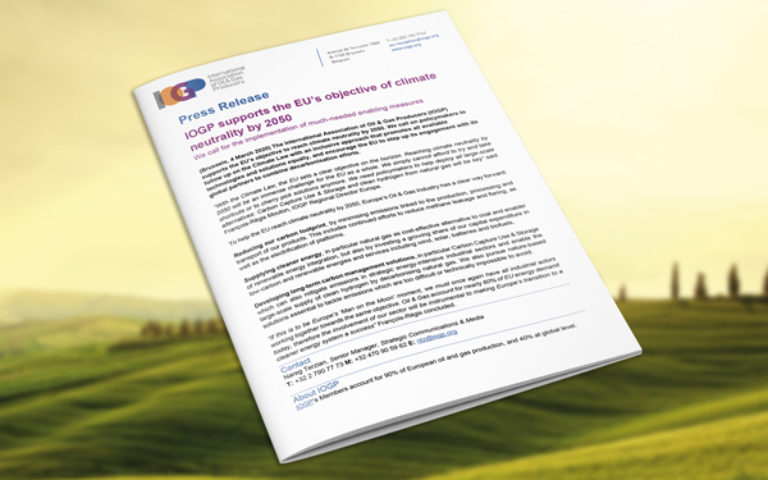
04.03.2020
Press Release
IOGP supports the EU’s objective of climate neutrality by 2050
(Brussels, 4 March 2020) The International Association of Oil & Gas Producers (IOGP) supports the EU’s objective to reach climate neutrality by 2050. We call on policymakers to follow up o...
Read more

26.06.2024 - 28.06.2024
SPE Europe Energy Conference
26-28 June, 2024
Turin, Italy
SPE Europe Energy Conference & Exhibition
IOGP Europe will join leaders from the energy, environment, geoscience, underground engineering, and policymaking...
Read more
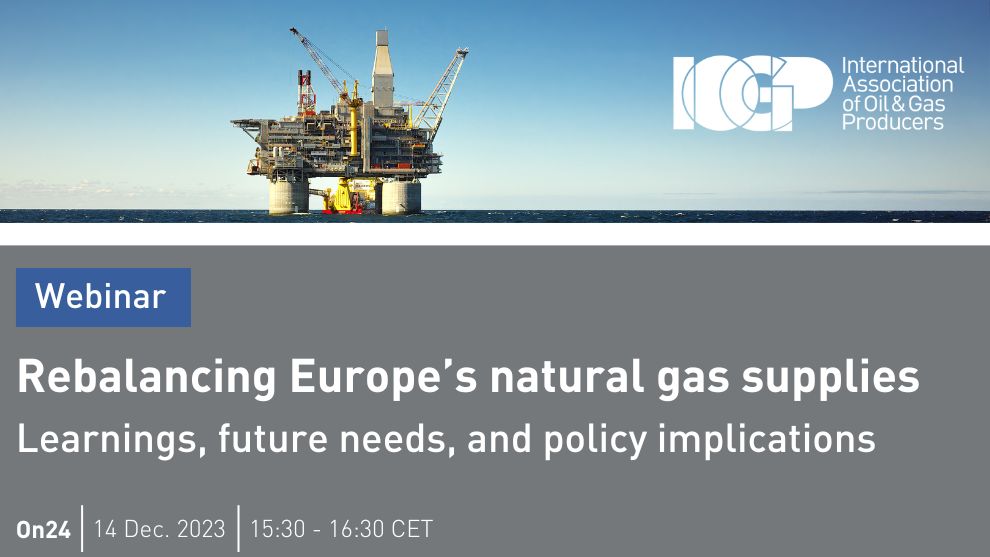
14.12.2023
Rebalancing Europe’s natural gas supplies – Learnings, future needs, and policy implications
What’s on the horizon for European gas markets?
Join us to take stock of what's happened since 2022, the supply challenges Europe still faces, the options it has to rebalance its natural gas su...
Read more

17.10.2023 - 18.10.2023
Scaling up the energy transition whilst securing a stable suppy
OCTOBER 17th-18th 2023, Brussels
4th Business Summit GO NET ZERO ENERGY
IOGP Europe will join industry leaders and decision-makers in this year’s 4th @GO NET ZERO ENERGY Brussels Business Summit o...
Read more
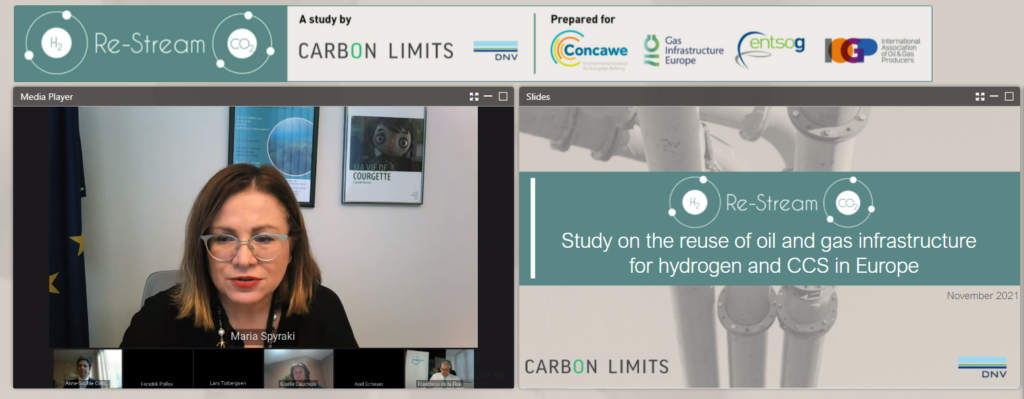
29.11.2021
Re-Stream Study Launch Event
The Re-Stream cross-industry study provides fact-based elements on the reuse of oil and gas infrastructure by identifying and assessing relevant infrastructure, and defining which technical adaptation...
Read more
